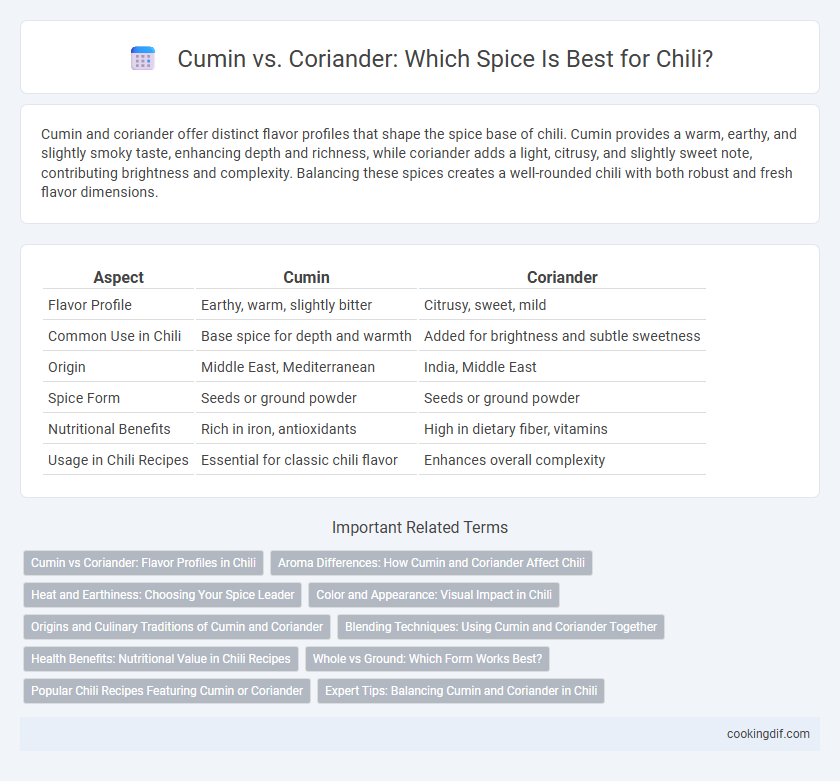Cumin and coriander offer distinct flavor profiles that shape the spice base of chili. Cumin provides a warm, earthy, and slightly smoky taste, enhancing depth and richness, while coriander adds a light, citrusy, and slightly sweet note, contributing brightness and complexity. Balancing these spices creates a well-rounded chili with both robust and fresh flavor dimensions.
Table of Comparison
| Aspect | Cumin | Coriander |
|---|---|---|
| Flavor Profile | Earthy, warm, slightly bitter | Citrusy, sweet, mild |
| Common Use in Chili | Base spice for depth and warmth | Added for brightness and subtle sweetness |
| Origin | Middle East, Mediterranean | India, Middle East |
| Spice Form | Seeds or ground powder | Seeds or ground powder |
| Nutritional Benefits | Rich in iron, antioxidants | High in dietary fiber, vitamins |
| Usage in Chili Recipes | Essential for classic chili flavor | Enhances overall complexity |
Cumin vs Coriander: Flavor Profiles in Chili
Cumin delivers a warm, earthy, and slightly smoky flavor that forms the backbone of many chili recipes, enhancing the savory depth and complexity. Coriander adds a citrusy, slightly sweet brightness that balances the richness and lifts the overall flavor profile. Combining cumin and coriander in chili creates a harmonious blend that intensifies the dish's spice base with both warmth and freshness.
Aroma Differences: How Cumin and Coriander Affect Chili
Cumin imparts a warm, earthy aroma with smoky undertones that intensifies the chili's depth, creating a robust and hearty flavor profile. Coriander offers a bright, citrusy fragrance with subtle floral notes, enhancing the chili's freshness and complexity. The combination of cumin and coriander balances warmth and brightness, elevating the overall sensory experience of chili dishes.
Heat and Earthiness: Choosing Your Spice Leader
Cumin delivers a deep, smoky earthiness with moderate heat that enhances chili's rich, savory profile, making it the preferred spice for bold, warming dishes. Coriander offers a brighter, citrusy earthiness with mild heat, adding a fresh and slightly sweet dimension that balances fiery chili flavors. Selecting cumin or coriander as your spice leader depends on whether you want your chili to emphasize warm depth or lively brightness in its heat and earthiness.
Color and Appearance: Visual Impact in Chili
Cumin seeds offer a warm, earthy brown hue that deepens the chili's color, creating a rich, rustic appearance. Coriander seeds, in contrast, provide a lighter, yellowish tone that brightens the dish with subtle golden highlights. The visual impact of cumin enhances the chili's hearty feel, while coriander adds an appealing, fresh contrast to the overall presentation.
Origins and Culinary Traditions of Cumin and Coriander
Cumin, originating from the Eastern Mediterranean and South Asia, has been a staple in Middle Eastern, Indian, and Mexican cuisines, known for its warm, earthy flavor that enhances chili dishes. Coriander, derived from the Mediterranean and Western Asia, is prized for its citrusy, slightly sweet notes and is widely used in Latin American and Indian culinary traditions to complement and balance spicy flavors. Both spices have deep-rooted cultural significance, shaping the distinctive taste profiles and aroma complexities in various global chili recipes.
Blending Techniques: Using Cumin and Coriander Together
Blending cumin and coriander creates a balanced spice base for chili, combining cumin's warm, earthy depth with coriander's citrusy, floral brightness. Toasting both seeds before grinding enhances their essential oils, intensifying flavors and promoting a harmonious fusion in the dish. Incorporating these spices in equal parts ensures a rich, complex foundation that elevates chili's overall taste profile.
Health Benefits: Nutritional Value in Chili Recipes
Cumin and coriander both enhance chili recipes with unique health benefits and nutritional profiles. Cumin is rich in iron and antioxidants, supporting immune function and digestion, while coriander offers vitamins C, K, and dietary fiber, promoting heart health and blood sugar regulation. Incorporating both spices not only intensifies flavor but also provides a balanced nutrient boost beneficial for overall well-being.
Whole vs Ground: Which Form Works Best?
Whole cumin and coriander seeds retain their aromatic oils longer than ground forms, providing a fresher, more intense flavor base for chili dishes. Grinding these spices just before cooking releases richer essential oils, enhancing the depth and complexity of the spice profile. Whole seeds are ideal for toasting and slow infusion, while ground spices offer convenience and immediate flavor impact in chili recipes.
Popular Chili Recipes Featuring Cumin or Coriander
Popular chili recipes often feature cumin for its warm, earthy flavor that enhances the rich, smoky profile of traditional Tex-Mex and Southwestern dishes. Coriander adds a citrusy, slightly sweet undertone, commonly used in chili recipes that emphasize bright, fresh ingredients and complex spice layers. The choice between cumin and coriander shifts the chili's overall character, with cumin providing depth and coriander offering a lighter, aromatic balance.
Expert Tips: Balancing Cumin and Coriander in Chili
Experts recommend balancing cumin and coriander to achieve a complex chili spice base, with cumin providing earthy, warm notes and coriander adding citrusy, floral undertones. Using a ratio of roughly 2 parts cumin to 1 part coriander enhances depth without overpowering the dish. Toasting both spices before grinding intensifies their flavors and elevates the overall chili profile.
Cumin vs Coriander for spice base Infographic

 cookingdif.com
cookingdif.com